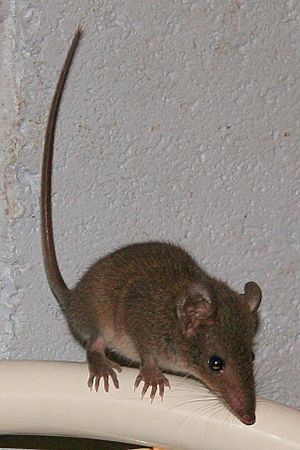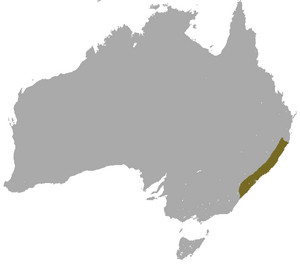Stuart's antechinus facts for kids
Quick facts for kids Brown antechinus |
|
|---|---|
 |
|
| Conservation status | |
| Scientific classification | |
| Genus: |
Antechinus
|
| Species: |
stuartii
|
 |
|
| Brown antechinus range | |
The brown antechinus (Antechinus stuartii) is a small, meat-eating marsupial. It is also known as Stuart's antechinus or Macleay's marsupial mouse. This tiny animal belongs to the Dasyuridae family, which includes other marsupials like quolls and Tasmanian devils.
One amazing fact about the brown antechinus is that the males die after their first breeding season. This makes them the world's smallest mammal known to reproduce only once in their lifetime. This special way of life is called semelparity.
Contents
What Does the Brown Antechinus Look Like?
The brown antechinus has light brown fur on its back and the top of its feet. Its belly and tail are a lighter shade of brown.
These small creatures are usually about 9 to 13 centimeters (3.7 to 5.1 inches) long, not including their tail. Their tail can be almost as long as their body, measuring about 9 to 12 centimeters (3.6 to 4.7 inches). They are very light, weighing only about 16 to 44 grams (0.5 to 1.5 ounces).
Unlike some other animals in its group, the brown antechinus does not have pale rings around its eyes. It looks very similar to the agile antechinus, and it can be hard to tell them apart without knowing where they live.
Where Does the Brown Antechinus Live?
The brown antechinus is found in eastern Australia. It lives in areas east of the Great Dividing Range. You can find them from southeastern Queensland down to an area called Kioloa, New South Wales.
These animals prefer to live in forests. They like places with lots of dense plants and bushes close to the ground. They also prefer areas where fires do not happen very often.
How Does the Brown Antechinus Behave?
The brown antechinus is mostly active at night, which means it is a nocturnal animal. It spends a lot of its time in trees, making it an arboreal creature.
Female brown antechinuses often build large nests together. Many individuals might share these nests.
Reproduction and Life Cycle
Like all antechinuses, the male brown antechinuses have a very short life after they reproduce. They die after their first breeding season, which only lasts about two weeks. This happens because of extreme stress and exhaustion from the breeding process. Scientists believe this intense effort helps them compete to pass on their genes.
Female brown antechinuses do not have a pouch like some other marsupials. Instead, their young attach themselves directly to the mother's teats. A mother usually has eight teats and gives birth to six or seven young at a time.
What Does the Brown Antechinus Eat?
The brown antechinus is an opportunistic feeder, meaning it eats whatever food it can find. Its diet mainly includes insects and other small creatures. They often eat beetles, spiders, small crustaceans called amphipods, and cockroaches.
Who Discovered the Brown Antechinus?
The brown antechinus was one of the first three species in its group to be officially described. For a long time, other similar species, like the agile antechinus, the subtropical antechinus, and the tropical antechinus, were thought to be the same as the brown antechinus.
The brown antechinus was described in 1841 by an entomologist named William Sharp Macleay. An entomologist is a scientist who studies insects. Macleay named the species after his friend, James Stuart. Stuart was a naturalist who found the animal in 1837 at Spring Cove in New South Wales. At the time, Stuart was working as a surgeon at a Quarantine Station.
See also
 In Spanish: Antequino pardo o de Stuart para niños
In Spanish: Antequino pardo o de Stuart para niños


